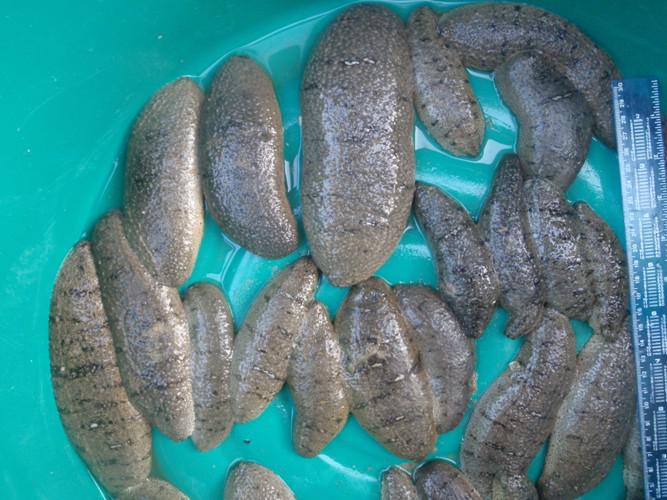Barry Bendell
Other projects
22 Mar 2012
Evaluation and Monitoring of Marine Protected Areas in Seagrass Meadows at Phra Thong Island,Thailand
The sea cucumber Holothuria scabra (sandfish) has been overharvested throughout its range, but this project will test a sustainable alternative to current harvesting and culturing practices. Adults will be conserved in protected areas while juveniles are harvested from outside protection and reared to market size in ponds.

Small sea cucumbers for stocking pond.
Holothuria scabra (sandfish) is an edible sea cucumber inhabiting tropical Indo-Pacific seagrass meadows. It is now endangered (IUCN Redlist) because of overharvesting. This project tests a sustainable alternative to current harvesting and culturing practices.
On Phra Thong Island, local communities have established protected areas in seagrass meadows where the harvesting of all animals is prohibited. We observed large adult Holothuria scabra in one such area, but they were few in number. Juveniles occurred outside protection and were sometimes abundant but small in size and so of little commercial value. It was proposed that those juveniles be harvested and reared to a commercial size while adult populations, which are easily over-exploited, remain protected.
Previous attempts to raise sea cucumbers in pens have not been successful locally. However in a recent trial, juveniles were stocked into an abandoned fish pond where they grew to a marketable size at a rate of 1.2 g/day over 11 months without the addition of food. The intertidal pond (500m2) was surrounded by mangroves and closed at its outlet by a net. The current project will attempt to replicate that success in the same pond and a least 3 others. The sustainability of the approach will be assessed by monitoring wild adult populations inside and outside protected areas.
The proposed approach has a number of advantages. Costs are low. Vulnerable adult populations are not exploited, and those in protected areas become a sustained breeding population and source of juveniles. Nets allow the exchange of water and small animals, such as young fish and shrimp, and ponds abandoned for other aquaculture purposes have some of their ecosystem functions restored while retaining economic value. Community-based aquaculture will be supported in concert with protected areas that are no-take zones for all animals, including others of economic importance.
When sea cucumbers in the ponds obtain a suitable size, they will be harvested, processed and dried in preparation for sale. The production of dried product, known as bêche-de-mer or trepang, will be evaluated to insure the best quality is obtained. The market and value chain will be investigated through interviews with fishers and traders to find the best possible price for local producers.
Seagrass is the foundation species for the ecosystem of which Holothuria scabra is an important part. The project will also continue a seagrass monitoring project which has been active on Phra Thong Island since 2009.